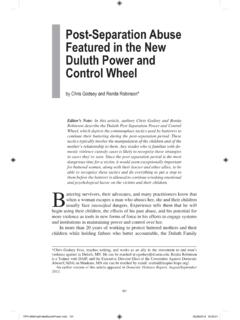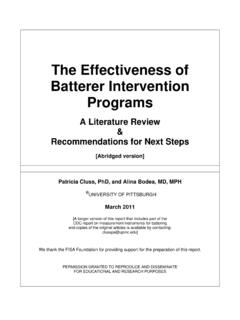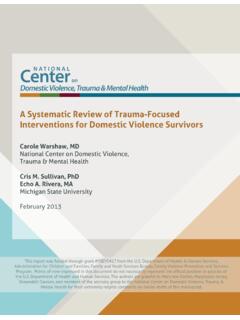Transcription of THE AUSTRIAN MODEL OF INTERVENTION IN DOMESTIC …
1 1 "Violence against women: Good practices in combating and eliminating violence against women" Expert Group Meeting Organized by: UN Division for the Advancement of Women in collaboration with: UN Office on Drugs and Crime 17 to 20 May 2005 Vienna, Austria THE AUSTRIAN MODEL OF INTERVENTION IN DOMESTIC VIOLENCE CASES Expert paper prepared by: Rosa Logar DOMESTIC Abuse INTERVENTION Center, Vienna and WAVE-Network pdfMachine by Broadgun Software - a great PDF writer! - a great PDF creator! - 2 The AUSTRIAN MODEL of INTERVENTION in cases of DOMESTIC violence 1.
2 Introduction In all regions of the world, women experience violence from their partners or male family members. For a long time, the extent of this violence could only be estimated, as the cases of violence which become known to the public are only the tip of an iceberg. In the past decade, the extent of violence against women was revealed in large-scale studies drawn up in several European countries. In the first representative study conducted in Germany with more than 10 000 women respondents it was found that approximately one out of four women ( , 25%) have experienced physical or sexual violence from a partner (Federal Ministry for Family Affairs, Senior Citizens, Women and Youth 2004).
3 According to an investigation within the framework of the British Crime Survey, 21% of all women become victims of physical violence or threats by a partner at least once in their lives (Walby/Allen 2004). In a prevalence study conducted in Finland (Heiskanen/Piispa 1998), 20% of all women living in a relationship responded that they had experienced violence from a partner. Apart from causing immense suffering, violence against women also results in costs for the victims and for society (Walby 2004, World Health Organization 2004).
4 In the course of her study, Walby found that the costs of DOMESTIC violence in England and Wales are an estimated 23 billion British pounds annually. Violence against women committed by male partners is not a private affair but a public and political problem. Acts of violence are human rights violations. Countries are bound under international agreements to prevent acts of violence against women and to protect the victims. However, a variety of obstacles still hinder the implementation of international standards for the protection of women against violence.
5 These obstacles are the long history and normality of exerting violence against women, the view of the problem as a private matter, the subordinate position of women in society and in the family and the role of violence in producing this subordination, prejudice and bias justifying violence against women, sexist, racist, misogynist and anti-human attitudes, neglect of the problem by politicians and lawmakers, ignorance of the responsible actors with regard to international human rights standards, lack of political will and insufficient allocation of means, lack of awareness, training and policy guidelines among the police and justice authorities, etc.
6 To overcome these obstacles, society will have to make enormous efforts. There is reason to assume that it will take several decades more to come close to the aim of eliminating violence against women. What we need, therefore, is long-term commitment. For making further progress and avoiding backlashes it is essential that the issue remain on the agenda of the United Nations and other international organizations. This UN study on violence against women and all other UN activities for the prevention of violence against women are of great importance for the development on the international scale.
7 Also, the human rights instruments and especially the work of the CEDAW Committee need to be strengthened. The prevention of violence against women should be effected on various levels of society: on the level of the State, the community and the individuals. Prevention falls into three categories: Primary prevention: precluding the emergence of violence ( , awareness raising, campaigns, community initiatives, human rights education, educational programs for kids and adolescents, 3 general measures against discrimination and in favor of actual equality of women, gender mainstreaming, etc.)
8 Secondary prevention: identifying risk factors and at-risk groups, providing help ( , sensitization programs in various institutions, establishing a helpline for women, health screening, measures to strengthen the independence of women at the legal, economic and social levels, initiatives supporting immigrant women, etc.) Tertiary prevention: measures to preclude further violence ( , helping the women affected by violence, establishing women s shelters, making laws for the protection against violence, considerate and effective police interventions , effective criminal court procedures, etc.)
9 2. The AUSTRIAN MODEL for the protection of women against violence In the following I will present the AUSTRIAN Protection Against Violence Bill. With this bill Austria has taken an innovative approach which has become a MODEL for other countries who have introduced similar legislation or are planning to do so. What is special and particularly effective about the AUSTRIAN MODEL is its close linking of legal and social measures. In my outline and analysis of the AUSTRIAN experience I will identify good practice indicators as well as problems and challenges.
10 I will refer to the practical experience in Austria and in other European countries as well as relevant research (WAVE 2002a, 2004; Humphreys et al 2000; Federal Ministry for Family Affairs, Senior Citizens, Women and Youth 2004a and 2004b; Kelly 2000; Hester/Radford 1998). First of all I would like to say that the AUSTRIAN MODEL is not a cure-all and that it mainly focuses on police and court interventions . A variety of models in many different spheres are necessary to prevent violence against women. However, the level of laws is of key importance in states with a democratic constitution.



















